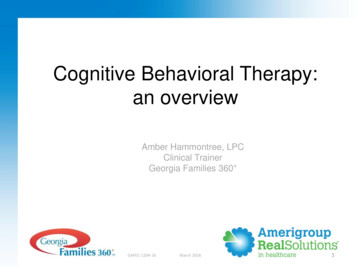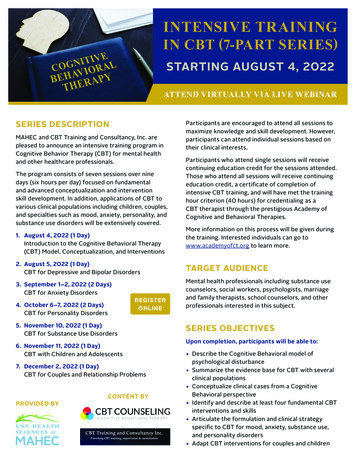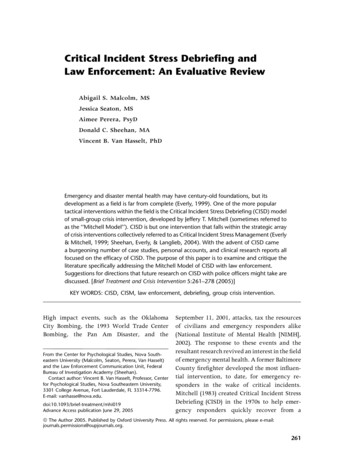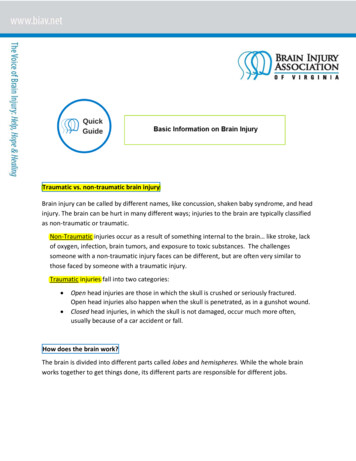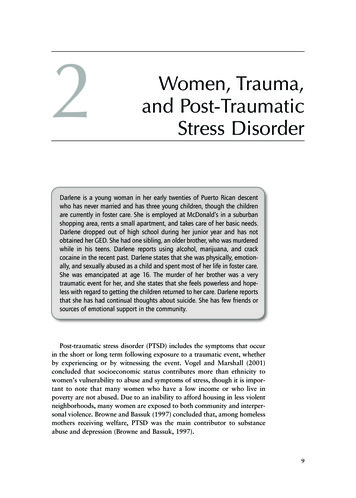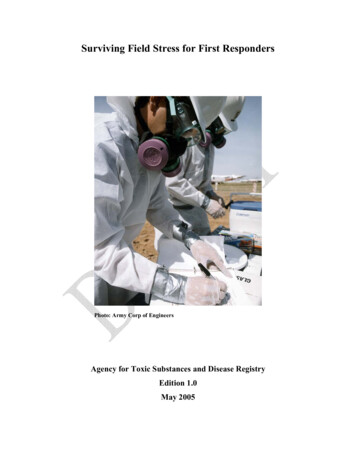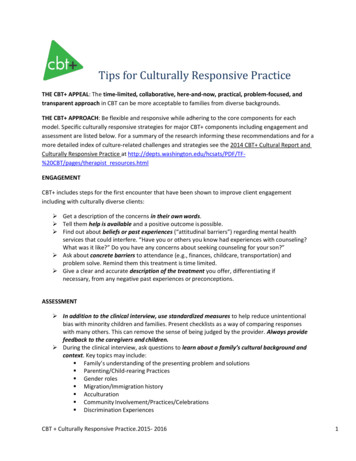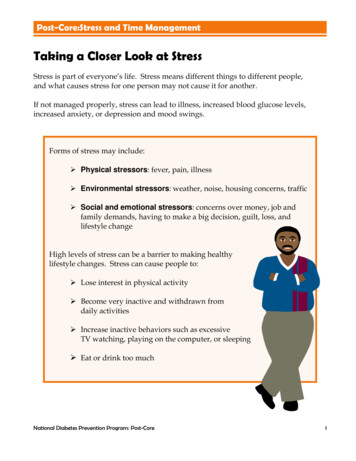
Transcription
CBT for Post‐TraumaticStress Disorder
CBT for PTSD Diagnosis and atmentTroubleshooting
Diagnosis (DSM‐IV‐TR; AmericanPsychological Association, 2000) Criterion A:Exposure to a traumatic event in which both of thefollowing were present:1) The person witnessed or was confronted with anevent or events that involved actual or threateneddeath or serious injury, or a threat to the physicalintegrity of the self or others2) The person’s response involved individualexperiences fear, helplessness or horror in responseto threatened or actual death, or threat to the self‐integrity of the self
Re‐experiencing Criterion B – 1 or more re‐experiencing phenomena Recurrent and intrusive distressing recollections of theevent, including images, thoughts or perceptions Recurrent, distressing dreams Acting or feeling as if the event were recurring – a sense ofreliving, illusions, hallucinations, and dissociative flashbacks Distress at exposure to internal or external cues thatsymbolise or resemble an aspect of the traumatic event Physiological reactivity to internal or external cues thatsymbolise or resemble an aspect of the traumatic event Be alert for different sensory modalities to re‐experiencingphenomena (e.g. smells, sounds, images, feelings)
Avoidance and numbing Criterion C ‐ Avoidance and numbing (3 or more)‐ Efforts to avoid thoughts, feelings, or conversations associatedwith the trauma‐ Efforts to avoid activities, places, or people that arouserecollections of the trauma‐ Inability to recall important aspects of the trauma‐ Markedly diminished interest or participation in significantactivities‐ Feelings of detachment or estrangement from others‐ Restricted range of affect‐ Sense of foreshortened future
Hyperarousal Criterion D ‐ 2 or more symptoms of hyperarousal‐ Sleep difficulties‐Anger‐Concentration difficulties‐Hyper‐vigilance‐Exaggerated startle response
Disturbance and Duration Present for more than one month (otherwiseconsider Acute Stress Disorder) Disturbing to important areas of functioning
Problems with PTSD Diagnosis PTSD symptoms may capture a limited aspect of posttraumaticpsychopathology (van der Kolk and Courtois, 2005) Co morbid problems common in routine clinical practice andsuch patients often excluded from RCTs More than 80% of patients with PTSD have co‐morbid disorders(Foa et al., 2000) Journal of Anxiety Disorders, 21, (2007) Brewin, C.R. (2003). Post‐traumatic stress disorder: Malady ormyth
Co‐Morbidity PanicGeneralised anxiety disorderDepression and suicideSubstance misuseAnger / ForensicNeuropsychological impairmentsChronic pain and other health problemsAxis II disordersPsychosisOCD
Incidence of PTSDIncidence Risk of developing PTSD after a traumatic event - 8.1%for men and 20.4% for women (Kessler et al.,1995)
Course and Prognosis After Trauma(NICE, 2006)Onset of symptoms usually in first month after trauma In 15% (McNally, 2003) may be a delay of months or years. Substantial natural recovery in initial stages High proportion of trauma survivors will initially develop symptoms ofASD/PTSD, most people will recover without tx Steep decline in PTSD rates in first year (e.g. Breslau et al,1991; Kessler et al,1995). At least 1/3 of individuals who develop PTSD remain symptomatic for 3 years and are at risk of secondary problems Likelihood that will benefit from treatment does not decrease with time sincetrauma (Gillespie et al, 2002; Resick et al, 2002).
Risk Factors – Impact of PreviousTrauma Studies of rape victims (Frank and Anderson,1987; Nishith, Mechanic, and Resick, 2000;Roth, Wayland, and Woolsey, 1990) havedemonstrated a relationship between priorvictimization, posttraumatic pathology, andproblematic recovery.
Cognitive Risk Factors Negative cognitions about self, world and self‐blame(Foa et al., 1999) Negative appraisals of symptoms, negative responsesfrom others, and permanent change (Dunmore et al.,1999, 2001) Alienation, perceived permanent change, and ‘Mentaldefeat’ (Dunmore et al., 1999, 2001; Ehlers, Maerckerand Boos., 2000)– Mental defeat ‐ “the perceived loss of all autonomy, a stateof giving up in one’s own mind all efforts to retain one’sidentity as a human being with a will of one’s own”
Stress Response Theory – Horowitz(1976,1986) When faced with trauma, initial response is outcry Second response is to assimilate the information Defence mechanisms (e.g. denial, numbing,avoidance) may help during period of overload The need to reconcile will cause info to burst intoconsciousness in flashbacks etc Oscillation between intrusions and avoidance untiltrauma processing is complete– Failure to do so PTSD
Ehlers and Clark’s Cognitive Model of PTSD (2000) PTSD becomes persistent when processing of theevent and/or its sequelae leads to a sense ofserious, current threat. Sense of threat may be due to appraisals of thetraumatic event and its sequelae, and the natureof the trauma memory.
Ehlers and Clark’s Cognitive Model ofPTSD (2000) ‐ Appraisals Fact that trauma happened ‐ Nowhere is safe''Trauma happened to me ‐ Others can see that I am a victim''Behaviour/emotions during trauma ‐ I cannot cope with stress''Initial PTSD symptoms Irritability, anger outbursts ‐ I can't trust myself'' Emotional numbing I'm dead inside'', Flashbacks, intrusions and nightmares ‐ I'm going mad'', Difficulty concentrating My brain has been damaged'‘ Other people's reactions after trauma Positive responses They think I am too weak to cope'‘ Negative responses Nobody is there for me'' Physical consequences My body is ruined'‘ Perceived permanent change, mental defeat and alienation seem to beparticularly pathogenic appraisals (Dunmore et al., 1999, 2001)
Ehlers and Clark’s Cognitive Model of PTSD(2000) – Memory Representations Trauma memories fundamentally different to otherautobiographical memories. Autobiographical memories– Organised– Contextualised– Characterised by “autonoetic awareness” (Tulving, 2002) Trauma memories– Poorly elaborated and incorporated into the autobiographical memorystore– Not given a complete context in time and place.
Ehlers and Clark’s Cognitive Model of PTSD(2000) – Coping strategies Certain coping strategies may inadvertently maintain the disorder Thought suppression (e.g. Steil and Ehlers, 2000) Rumination (Steil and Ehlers, 2000) Safety behaviours (Dunmore, Clark and Ehlers, 2001) Avoidance of reminders (Bryant and Harvey, 1995) Dissociation (Halligan et al., 2003) These strategies may produce PTSD symptoms, prevent change inappraisals, and prevent change in the trauma memory.
Ehlers and Clark’s Cognitive Model of PTSD(2000) Characteristics of traumatic event, state factors, pre‐trauma beliefs, coping etc. influence PTSDdevelopment and maintenance Model distinguishes between data‐driven andconceptual processing. If peri‐traumatic processing is predominately data‐driven then:– Trauma memory may be difficult to retrieve– Strong perceptual priming for similar stimuli– Stimulus discrimination may be impaired.
Cognitive Model of PTSD (Ehlers & Clark, 2000)Characteristics oftrauma/sequelae/ state ofindividual/ priorexperiences/ coping/beliefsCognitiveprocessingduringtraumatic eventInfluencesLeads toPreventschange inNegative Appraisal of Traumaand/or its SequelaeNature of TraumaMemoryMatchingTriggersCurrent ThreatIntrusionsArousal SymptomsStrong EmotionsStrategies Intended to Control Threat/Symptoms
Standard PTSD Treatment Different types of treatment may be described as CBT forPTSD– Stress inoculation training– In vivo exposure– Imaginal exposure– Cognitive restructuring Exposure based techniques for PTSD are effective (Bradley etal., 2005; Harvey et al., 2003; Roth and Fonagy, 2005). Most current CBT interventions for PTSD involve imaginalexposure (Richards and Lovell, 1999)
Prolonged Exposure Imaginal Exposure (IE) Patient asked to vividly imagine the traumatic eventfor a prolonged period (typically at least 50 minutes) Provides narrative in the first person, present tense Focusing on the most distressing moments Homework of listening to tape In vivo exposure Graded exposure to feared situations
Benefits of Exposure (Harvey et al.,2003)1. Promotes habituation2. Corrects belief that anxiety remains unless youavoid3. Impedes negative reinforcement of escape thenfear reduction4. Promotes incorporation of corrective informationinto the trauma memory5. Establishes trauma as a discrete entity, notindicative of the world being threatening6. Self‐mastery through exposure
Factors That Impede Emotional Processing Jaycox and Foa, 1996– Anger– Emotional numbing– Overwhelming anxiety Lee, Scragg and Turner (2001)– Shame– Guilt– Humiliation Ehlers et al., 1998– Mental defeat– Alienation– Perceived permanent change
Assessment Establish safety and trustProblem description– Key cognitions, emotions, behaviours, and attentionalchangesDescription of traumatic event(s) – non‐reliving– Begin to identify ‘hotspots’Background infoSuitability for treatmentIdentify therapy interfering cognitions and behaviourNormalising and psycho‐educationSocialisation into treatment
Assessment – Measures Clinician Administered PTSD Scale (CAPS) – Blake etal., 1995 Impact of Events Scale – Revised (IES‐R) – Weiss andMarmar, 1997 Posttraumatic Stress Cognitions Inventory(PTCI) –Foa et al. (1999a) Posttraumatic Stress Disorder Scale (PDS) – Foa etal., 1997 Dissociative Experiences Scale – II ‐ Carlson andPutnam, 1993 Co‐morbid disorder specific measures
Characteristics of trauma/sequelae/ stateof individual/ prior experiences/coping/beliefsCognitive processingduring traumatic eventInfluencesLeads toPreventschange inNature of Trauma MemoryNegative Appraisal of Trauma and/or its SequelaeMatching TriggersCurrent ThreatStrategies Intended to Control Threat/Symptoms
CBT Treatment (Ehlers and Clark, 2000) ‐ I Treatment involves a number of components:– Modifying negative appraisals– Elaborating trauma memories and improvingdiscrimination of triggers– Dropping dysfunctional behaviours and cognitivestrategies. A range of CBT techniques may be used to achieve these aims The focus of this talk will be the Ehlers and Clark (2000) andGrey, Young and Holmes (2002) approaches
Treatment GoalsClark and Ehlers (2004)Trauma memoryAppraisals of trauma and/orsequelaeelaborateTriggersidentify and modifydiscriminateCurrent threatintrusionsarousalStrong emotionsreduceDysfunctional behaviours/ cognitive strategies give up
CBT Treatment (Grey et al., 2002; Ehlers and Clark,2000) ‐ II Stages of treatment include:– Assessment– Psychoeducation– Reliving with CR– In vivo exposure– Stimulus discrimination– Reducing avoidance and safety behaviours– Total duration of therapy likely to be between 8and 20 sessions (Grey et al., 2002)
Psychoeducation Normalise– Symptoms as a common initial reaction to an abnormal event– The patient’s ways of coping may have been helpful for milderstressful events but now may be maintaining the problem(thought suppression exercise may help) Educate– Cupboard/duvet analogy– Neuroanatomical / guard dog Reclaiming your life– ‘memory talking’ or trauma as robber (Stott et al., 2010)– Evidence for efficacy of Behavioural Activation for PTSD(Jakupcak et al., 2006)
Cupboard Analogy (Stott et al., 2010) Memory like a food cupboard Usually organised and add and remove thingsone at a time Trauma – given lots of tins etc and told “putthem away, quick!!” ‐ so cram things in andtry to close doors But, things keep falling out because theydon’t fit – you push them back in, but samepattern occurs What do you need to do?
Phases in addressing peritraumatic emotionalhotspots – Grey, Young and Holmes, 2002Phase 1: initial reliving Rationale for reliving Identify peritraumatic emotional hotspots during reliving Identify associated cognitions/meaningsPhase 2: cognitive restructuring (CR) outside reliving Discuss hotspots and attempt CR outside reliving Rationale for CR within reliving Rehearse reappraisals for later relivingPhase 3: cognitive restructuring within reliving Reliving of whole event/focus on specific hotspot Hold hotspot vividly in mind (rewind-and-hold)
How to tell ‘hotspots’ in relivingClues: affect change– Red– Shaky– Sweaty etc avoidance; change in tense & person skip over / whiz through parts gaps in narrative and missing content associatedwith flashbacks/intrusionsKerry Young and Deborah Lee
Safety Behaviours – Ehlers and Clark,2000 Patients may use a range of safety behavioursthat reduce current threat but maintain theproblem in the long term– Prevent trauma memory elaboration (e.g.avoidance of talking)– Prevent reappraisal Discuss problematic consequences ofbehaviour, then test dropping it
Appraisals and Associated Behavioural andCognitive Strategies – Ehlers and Clark, 2000AppraisalDysfunctional StrategiesIf I think about the trauma I’ll gomad, lose control, heart attack etcThought suppression, alcohol / drugs /benzos, keep mind occupied, controlfeelingsIf I have a flashback, then I will beunable to breathe and will suffocateSleep near the windowIf I do not check for intruders then myfamily will be attackedStay up at night, hypervigilant tosounds outside flatIf I talk to my friends, then they willask about the event and I’ll fall apartAvoid friendsIf people see me and my stick, thenthey will see I’m weak and attackDon’t use walking stick, avoid eyecontact, baseball cap
In Vivo Exposure / Behavioural Activation Revisiting the scene of the trauma may help to placememory in the past, also may help with discriminationof then and now Goal is to elaborate and reappraise situation Behavioural experiments for feared predictions– Drop safety behaviours– Facilitate full emotional exposure– Stimulus discrimination Emerging efficacy of the benefit of BA for PTSD(Janupak et al., 2006; Wagner et al., 2006)
Stimulus Discrimination – Clark andEhlers, 2004 Ehlers and Clark (2000) model suggests thattrauma memory elaboration leads to betterdiscrimination of then and now and that this mayreduce probability of re‐experiencing So, stimulus discrimination in 2 stages1. Identify when and where triggers occur2. Break the link between triggers and traumamemory – may help to discuss differences
Flashback halting protocol (adapted fromRothschild, 2000) Right now, I am feeling .(name emotion), And I am sensing in my body . (bodily feelings) Because I have been reminded of (name thetrauma by title only – no details) By, (describe the trigger) At the same time, I am looking around where I am nowin .(the current year) Here in (the current location) And I can see, (describe surroundings) And so I know that the (traumatic event) Is not happening now / anymore
Factors That May Impede EmotionalProcessing AngerShameGuiltMental defeatAlienationPerceived permanent changeEmotional numbingOverwhelming anxietyAvoidance of affect
Avoidance of Affect – Butler, Fennell,and Hackmann, 2008 Many patients have a self‐protective modewhich helps them to avoid feelings and/orexpressing emotions In PTSD AoA can impair emotional processing,may lead to negative appraisals, and safetybehaviours May be a cultural dimension to this
Identifying Avoidance of Affect – Butler, Fennell,and Hackmann, 2008 Common signs include:– Gaze changes– Fidgeting, change in position– Changing topic– Intellectualising– Rumination/worry– Jokes– Appears to not understand– Emotional disengagement/withdrawal– Keeps you talking– Indecisive– Goes blank, dissociates, forgets– Binge eating/drinking, drugs
Treating Avoidance of Affect – Butler, Fennell,and Hackmann, 2008 Build safety within relationship Elicit feelings– Listen, reflect, notice when changes emerge Educate about emotions Decatastrophize External attention – examine the reactions of others Feedback about therapy Accept and validate negative feelings Recording – second chance to identify feelings Metaphor Reduce safety behaviours (see Butler and Surawy, 2004)
What causes dissociation?1. Physical injury (e.g. head injury,temporal lobe epilepsy, pain)2. Legal and illegal drugs (cannabis,benzodiazepines)3. Psychological trauma
Why is dissociation important? Dissociation during trauma (peri‐traumatic) is asignificant predictor of PTSD High levels of post‐traumatic dissociation areassociated with more severe trauma –childhoodtrauma and/or chronic trauma (e.g. torture) Often present in people meeting criteria forBorderline Personality Disorder
Why does dissociation matter clinically?Risks General – loss of awareness of surroundings, e.g. walkingout into traffic etc.use of self‐harm to terminate dissociation Treatment‐ if someone is liable to dissociate duringreliving, they will not be able to process the traumamemory. So need to teach them to control their dissociation usinggrounding strategies
Dissociation ‐Treatment Psycho‐education about the relationshipbetween dissociation and trauma – need tohelp people understand what is happening tothem and why Need to formulate when dissociation occurs,what the triggers are, and what terminates it
Grounding Strategies1. Attentional techniques (distracting attentionfrom the trigger or refocussing attention oncurrent surroundings)2. Grounding words or phrases (check trauma‐related associations)3. Grounding Objects (e.g. stress balls)4. Grounding Images (safe place imagery)5. Sensory Stimuli (essential oils, polos) See Kennerley (1996)
Finally, McHugh and Treisman\爀屮\ 㜀尩 argue that t\൨e diagnosis has moved the mental health field from, rather than towards, an\爀屮understanding of natural psychological responses 對to trauma.\爀屮The most salient unifying theme across these contributions is the questionable validity of the\爀屮DSM-IV PTSD diagn\൯stic .
